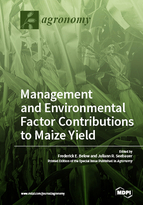Environmental and Management Factor Contributions to Maize Yield
A special issue of Agronomy (ISSN 2073-4395). This special issue belongs to the section "Innovative Cropping Systems".
Deadline for manuscript submissions: closed (5 November 2018) | Viewed by 61241
Special Issue Editors
Interests: maize and soybean high-yield management; crop physiology; crop production; nitrogen use efficiency
Special Issue Information
Dear Colleagues,
Agricultural production must increase substantially to meet the increasing per capita demand for food, feed, fuel, and fiber of a rising human census. The amount of arable land is limited due to soil type, weather, and ecosystem considerations; therefore, it is necessary to increase yields on current fields. To obtain the greatest maize (Zea mays L.) yield, a farmer needs to nurture the crop as much as possible. Weather and nitrogen availability are well- known as two factors that normally have the greatest influence on maize yields and grain quality. Some management factors a producer may need to consider while growing a maize crop are mineral fertilization, genotype, plant population, and protection from insects and diseases. Additionally, there are numerous biological and chemical compounds that can stimulate plant growth, such as in-furrow mixes and foliar fungicides. Field management also plays a role in final grain yield, including crop rotation, tillage, soil pH and nutrient levels, weed control, and drainage.
This Special Issue will focus on weather and other maize crop management factors and their relative independent and/or interactive influence on maize growth and yield. We welcome novel research and reviews relating to improved crop management for the greatest maize yields.
Prof. Frederick E. BelowMs. Juliann R. Seebauer
Guest Editors
Manuscript Submission Information
Manuscripts should be submitted online at www.mdpi.com by registering and logging in to this website. Once you are registered, click here to go to the submission form. Manuscripts can be submitted until the deadline. All submissions that pass pre-check are peer-reviewed. Accepted papers will be published continuously in the journal (as soon as accepted) and will be listed together on the special issue website. Research articles, review articles as well as short communications are invited. For planned papers, a title and short abstract (about 100 words) can be sent to the Editorial Office for announcement on this website.
Submitted manuscripts should not have been published previously, nor be under consideration for publication elsewhere (except conference proceedings papers). All manuscripts are thoroughly refereed through a single-blind peer-review process. A guide for authors and other relevant information for submission of manuscripts is available on the Instructions for Authors page. Agronomy is an international peer-reviewed open access monthly journal published by MDPI.
Please visit the Instructions for Authors page before submitting a manuscript. The Article Processing Charge (APC) for publication in this open access journal is 2600 CHF (Swiss Francs). Submitted papers should be well formatted and use good English. Authors may use MDPI's English editing service prior to publication or during author revisions.
Keywords
- Crop production
- Maize high-yield
- Crop management
- Crop fertilization
- Maize rotation
- Crop protection
- Population density






